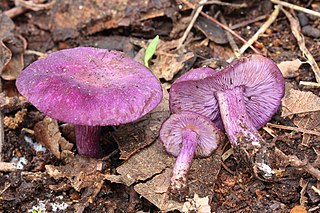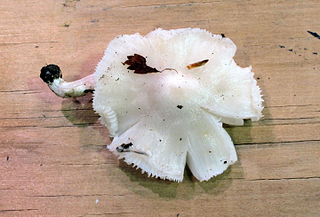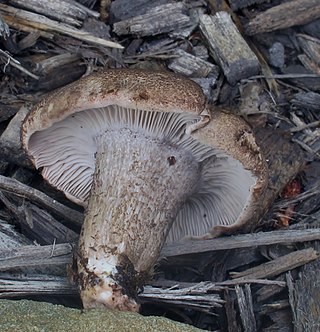Related Research Articles

Rolf Singer was a German-born mycologist and one of the most important taxonomists of gilled mushrooms (agarics) in the 20th century.

The Hygrophoraceae are a family of fungi in the order Agaricales. Originally conceived as containing white-spored, thick-gilled agarics, including Hygrophorus and Hygrocybe species, DNA evidence has extended the limits of the family, so it now contains not only agarics, but also basidiolichens and corticioid fungi. Species are thus diverse and are variously ectomycorrhizal, lichenized, associated with mosses, or saprotrophic. The family contains 34 genera and over 1000 species. None is of any great economic importance, though fruit bodies of some Hygrocybe and Hygrophorus species are considered edible and may be collected for sale in local markets.

The Tricholomataceae are a large family of fungi within the order Agaricales. Originally a classic "wastebasket taxon", the family included any white-, yellow-, or pink-spored genera in the Agaricales not already classified as belonging to e.g. the Amanitaceae, Lepiotaceae, Hygrophoraceae, Pluteaceae, or Entolomataceae.
Marasmiellus cocophilus is a species of fungus in the family Marasmiaceae. It was described as new to science in 1969 by mycologist David Pegler. The fungus causes lethal bole rot of coconut.
Arthrosporella is a fungal genus in the family Tricholomataceae. It is a monotypic genus, containing the single species Arthrosporella ditopa, found in South America. The genus was described by mycologist Rolf Singer in 1970.
Cynema is a genus of fungi in the family Tricholomataceae. This is a monotypic genus, containing the single species Cynema alutacea, found in Papua New Guinea.
Tricholosporum goniospermum is a species of fungus in the family Tricholomataceae, and the type species of the genus Tricholosporum. First described scientifically by Giacomo Bresadola in 1881 as Tricholoma goniospermum, it was transferred to the genus Tricholosporum, established in 1975 by Mexican mycologist Gaston Guzman. As was pointed out in a 1982 publication by Tim Baroni, the transfer was not valid, "because complete reference to the authors and the original publications of the basionyms was not provided". Baroni made the new combination official in his publication.
Tricholosporum atroviolaceum is a species of fungus in the family Tricholomataceae.
Tricholosporum cossonianum is a species of fungus in the family Tricholomataceae.
Tricholosporum laeteviolaceum is a species of fungus in the family Tricholomataceae. Found in South Africa, it was described as new to science in 1998.

Tricholosporum porphyrophyllum is a species of fungus in the family Tricholomataceae. It is found in Asia.
Tricholosporum subgoniospermum is a species of fungus in the family Tricholomataceae. Known from Hungary, the species was described as new to science in 1999.
Tricholosporum subporphyrophyllum is a species of fungus in the family Tricholomataceae. Found in Mexico, the species was described as new to science in 1975 by Mexican mycologist Gaston Guzman.

Tricholosporum tropicale is a species of fungus in the family Tricholomataceae. It is found in Mexico.
Tricholosporum violaceum is a species of fungus in the family Tricholomataceae. Found in Costa Rica, the species was described as new to science in 1996.

Albomagister is a genus of fungi in the family Tricholomataceae. The genus contains just one named species known from Tennessee and North Carolina, however two other undescribed species have been sequenced. Albomagister was described by mycologists Marisol Sánchez-García, Joshua Birkebak & P. Brandon Matheny in 2014 with Albomagister subaustralis as the type species.
Corneriella is a genus of fungi in the family Tricholomataceae. The genus contains two species known from the United States and Thailand, and at least four others have been detected by DNA sequencing. Corneriella was described the mycologist Marisol Sánchez-García in 2014 with Corneriella bambusarum as the type species.

Pseudotricholoma is a genus of fungi in the family Tricholomataceae. The genus contains three species known from North America. Europe, and the Azores. Basidiocarps resemble those of the genus Tricholoma, with a dry fibrillose pileus and white to brown lamellae that have adnate to emarginate attachment and stain reddish when damaged, eventually turning black. Microscopically, the basidiospores are smooth, ellipsoid to ellipsoid-oblong, thin-walled and amyloid. Cheilocystidia are rare to absent and pleurocystidia are absent. The pileipellis is a cutis and clamp connections are present. Species in Pseudotricholoma are found on soil in grasslands and woods. They are probably biotrophic, and may be ectomycorrhizal.
Tricholoma zangii is a mushroom of the agaric genus Tricholoma. The species was originally described by mycologist Mu Zang in 1990, who called it Tricholoma quercicola. It was later discovered that this name was a later homonym of a North American species described by William Alphonso Murrill in 1949, and a new name was needed.
References
- ↑ Guzmán G, Montoya L, Bandala VM (1990). "Observations on the genera Asproinocybe and Tricholosporum, and description of a new species of Tricholosporum (Agaricales, Tricholomataceae)". Mycotaxon . 38: 485–95.